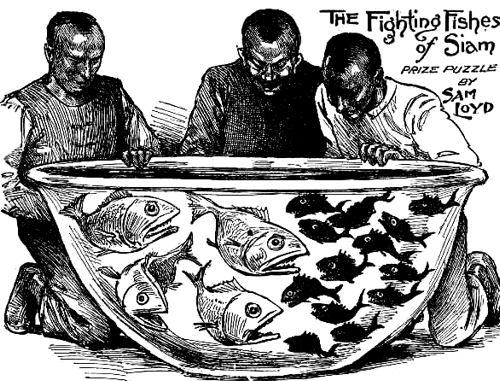



THE PEOPLE OF Siam are natural born gamblers, who would bet their last vestige of clothing upon any event which offers a chance to win or lose. They are not especially belligerent themselves, but they love to witness a fight between any other creature from a toad to an elephant. Dogfights or cocking mains are of daily occurrence and are conducted pretty much according to the recognized lines of civilized countries, but in no other land upon the globe is it possible to witness a fish fight!
They have two kinds of fish, which, despite their being very choice food, are raised and valued solely for their fighting qualities. The one is a large white perch, known as the king fish, and the other is the little black carp, or devil fish. Such antipathy exists between these two species of fish that they attack each other on sight and battle to the death.
A kingfish could readily dispose of one or two of the little devilfish, but their methods or tactics are so agile and they work together so harmoniously that three of the little fellows would just equal one of the big ones, and they would battle for hours without any results. So cleverly and scientifically do they carry on their line of attack that four of the little fellows would kill a large one in just three minutes and five would administer the coup de grace proportionately quicker.
These combinations of adverse forces are so accurate and reliable that the feature of a fish tournament is to calculate upon the exact time it will take a given number of one kind to vanquish a certain number of the enemy.
By way of illustration a problem is presented in simple puzzle form with four of the kingfish opposed to thirteen of the little fighters.
Who should win? And how long should it take one side to annihilate the other?
This problem was presented to me at Bangkok and, while owing to the peculiar complications of the case, it took me quite a long time to figure out the correct solution from a mathematical standpoint, I found that any Malay youth would give the same answer off hand, either by intuition or from knowledge obtained from practical experience. But it is an actual fact that everyone seemed to know to a second the time required for a certain number of fish to destroy another given number of opponents with but a small margin of deviation contingent upon the better quality of the fishes or the accidental fortunes of war.
There would certainly have been a battle royal in the Siamese aquarium had there been as many fishes in that fight as I have received answers to the problem, and they all maintained much different views. There are answers galore worked out in trigonometry and algebra, showing how one side or the other should win out in from one to twelve minutes.
For clearness and simplicity as agreeing with the actual record of the last fight I am inclined to accept the following decision of the time-keeper as being correct:
Three of the little fish were paired off with each of three of the big fish and engaged their attention while the other four little fighters polished off the fourth big one in just three minutes. Then five little fellows tackled one big fish and killed him in two minutes and twenty seconds, while the other little ones were battling with the other big ones. It is evident that if the remaining two groups had been assisted by one more fighter they would have finished in the same time, so there is only sufficient resistance left in each of the big ones to call for the attention of a little fish for two minutes and twenty-four seconds. Therefore if seven now attack instead of one, they would do it in one-seventh of that time, or twenty and four-sevenths of a second. In dividing the little fish forces against the remaining two big ones — one would be attacked by seven and the other by six — the last fish therefore at the end of the twenty and four-sevenths seconds would still require the punishment which one little one could administer in that time. The whole thirteen little fellows concentrating their attack, would give the fish his quietus in one-thirteenth of that time, or one and fifty-three ninety-first seconds.
Adding up the totals of the time given in the several rounds — 3 minutes, 2 minutes and 24 seconds, 20 4/7 seconds and 53/91 seconds, we have 5 minutes 46 2/13 seconds as the entire time consumed in the battle.
2.
Why are married men like steam-boats? Because they are sometimes blown up.
What ship contains more people than the “Great Eastern?” Courtship.
Why do women make good post- office clerks? Because they know how to manage the mails (males).
Why is lip salve like a chaperon? Because it is intended to keep the chaps away.
What is worse than raining cats and dogs? Hailing omnibuses.
Why is an umbrella like a pancake? Because it is seldom seen after Lent.
What is that which every living person has seen, but will never see again? Yesterday.
What is the difference between dead soldiers and repaired garments? The former are dead men, and the latter are mended (dead).
[Page 79]